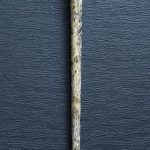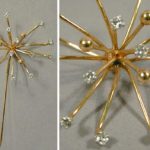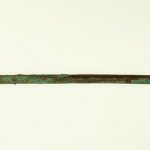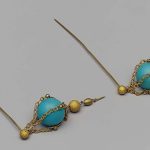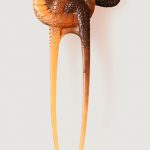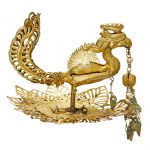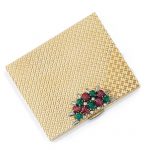Hair Pins. A hair pin or hairpin is a long device used to hold a person’s hair in place. It may be used simply to secure long hair out of the way for convenience or as part of an elaborate hairstyle or coiffure. The earliest evidence for dressing the hair may be seen in carved “venus figurines” such as the Venus of Brassempouy and the Venus of Willendorf. The creation of different hairstyles, especially among women, seems to be common to all cultures and all periods and many past, and current, societies use hairpins.
Hairpins made of metal, ivory, bronze, carved wood, etc. were used in ancient Assyria and Egypt for securing decorated hairstyles. Such hairpins suggest, as graves show, that many were luxury objects among the Egyptians and later the Greeks, Etruscans, and Romans. Major success came in 1901 with the invention of the spiral hairpin by New Zealand inventor Ernest Godward. This was a predecessor of the hair clip.
The hairpin may be decorative and encrusted with jewels and ornaments, or it may be utilitarian, and designed to be almost invisible while holding a hairstyle in place.
Some hairpins are a single straight pin, but modern versions are more likely to be constructed from different lengths of wire that are bent in half with a u-shaped end and a few kinks along the two opposite portions. The finished pin may vary from two to six inches in final length. The length of the wires enables placement in several styles of hairdos to hold the style in place. The kinks enable retaining the pin during normal movements. Reference: Wikipedia
A MOTTLED BLACK AND WHITE JADE HAIR PIN YANGSHAO CULTURE, CIRCA 5000-3000 BC The long pin tapers to a point at one end and with a flat ovoid head at the other. The stone is of a mottled dark grey and creamy white tone with soft polish. 6 7/8 in. (17.4 cm.) long, box
Sold for HKD 62,500 at Christie’s in 2019
Diamond Hair Pin 14 kt. yellow gold, of starburst design, set with thirteen assorted round diamonds, total approximately .50 ct., approximately 4.1 dwt.
Sold for $225 (includes buyer’s premium) at Doyle in 2002
Hair pin ca. 1295–1070 B.C.
Reference: The Metropolitan Museum of Art
Kingfisher feather hairpin Gilt silver hairpin decorated with mallow and bats inlaid with kingfisher feather, pearls and jewels.
Reference: Museum of Applied Art and Sciences
Hair pins French about 1865
Reference: Museum of Fine Arts Boston
René Lalique HAIR PIN, CIRCA 1900-1905 horn and turquoise Signed LALIQUE 19,9 x 7,1 cm ; 7 7/8 x 2 3/4 in.
Sold for 38,750 EUR at Sotheby’s in 2018
